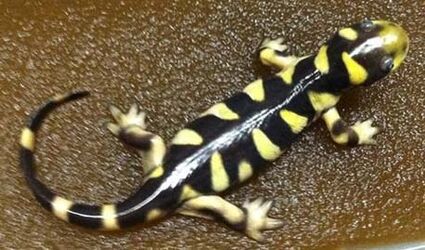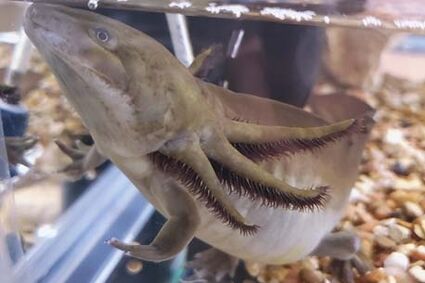Kansas Day – 2023! The Barred Tiger Salamander
January 26, 2023

Photo courtesy of California DFW.
Since 1994, the Barred Tiger Salamander has been the State Amphibian of Kansas. These salamanders may grow to 13 or 14 inches long. They are nocturnal and spend much of their lives underground.
Kansas Day is celebrated on Jan. 29. This year, Kansas will be 162 years old. Kansas has several nicknames "the Sunflower State" and "the Wheat State" being but two.
Kansas also has symbols which represent the State in some way. To date, there are 22 such state symbols.
Among those Kansas symbols: a state fruit – the sand hill plum, a state soil – Harney Silt Loam, a state rock – Greenhorn Limestone and a state fish – channel catfish. Most know about the cottonwood tree, honey bee, sunflower, "Home on the Range" and the buffalo.

The Barred Tiger Salamander, the State Amphibian of Kansas, most generally moves onto land as an adult. Except when the larval stage is unable to move onto land. Then the adult salamander matures in the neotonic state. The creature retains the gills of the larval stage and remains in an aquatic environment. It does not gain the spots of those who move to land. This salamander lives at the Kansas Wetlands Education Center near Great Bend.
Though the Barred Tiger Salamander is not one of the most well-known symbols. It has been the state amphibian for nearly 30 years. Designated in 1994, it was first nominated by the second-grade class of OK Elementary School in Wichita.
These salamanders can grow to be 13 to 14 inches long. As adults, barred tiger salamanders are nocturnal animals. Though living on land, they spend much of their time underground. Not picky eaters, they eat grasshoppers, crickets, earthworms, tadpoles and even mice. The barred tiger salamander is mute, making no sounds at all.
As an amphibian, its life cycle begins as an egg in water. The egg develops into a "mud puppy." This larval stage has external gills and four legs. As an adult, the legs remain but the gills are lost and the animal begins to live on land. Except if there is no way the larval stage can move onto land, then the salamander matures in the larval stage. This stage is called Neotony.
The Kansas Wetlands Education Center recently had the opportunity to rescue and relocate 60 neotenic salamanders. These salamanders were trapped in an abandoned basement. The one pictured with this article resides at the education center near Great Bend. Though in the neotonic state, it is still a barred tiger salamander – the Kansas State amphibian.



Reader Comments(0)